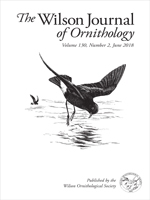Biologists interested in using radio telemetry to track the movements of birds should concurrently conduct studies to assess potential impacts on study organisms, particularly when monitoring threatened or endangered species. We investigated the effects of traditional and digital very high frequency (VHF) radio transmitters on daily nest survival and chick survival rates of Piping Plovers (Charadrius melodus) along the Atlantic Coast in 2012, 2013, and 2015. We attached 1.0–1.2 g transmitters to 110 plovers and monitored their 160 nest attempts. We also monitored 221 nest attempts by 161 control pairs with no transmitters. There was no evidence that nest or chick survival differed between tagged and control pairs. Transmitters did not seem to adversely impact Piping Plover daily nest and chick survival and are a valuable tool to monitor movements of this threatened species.
How to translate text using browser tools
1 June 2018
Radio transmitters did not affect daily nest and chick survival of Piping Plovers (Charadrius melodus)
Michelle L. Stantial,
Jonathan B. Cohen,
Abigail J. Darrah,
Kate E. Iaquinto,
Pam H. Loring,
Peter W. C. Paton
ACCESS THE FULL ARTICLE

The Wilson Journal of Ornithology
Vol. 130 • No. 2
June 2018
Vol. 130 • No. 2
June 2018
Charadrius melodus
chick survival
endangered species
nest survival
researcher effect




